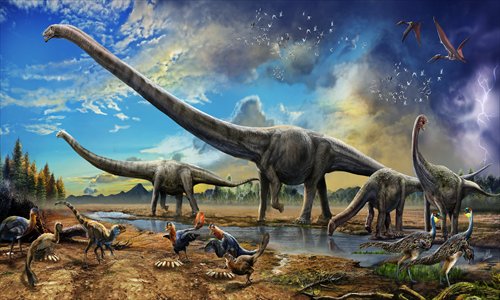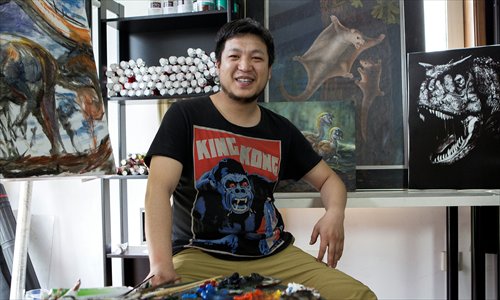HOME >> ARTS
Dinosaurs alive!
By Xiong Yuqing Source:Global Times Published: 2014-4-28 21:28:01

Ruyangosaurus giganteus Lü et al., 2009 Photo: Courtesy of Zhao Chuang
An ancient orange bird-like creature stretches out its feathered wings to fly; an ancient frog waits beside a pond staring at its prey; dolphin-like creatures wander pale blue oceans ...these vivid and colorful images depicting Earth as it may have appeared over 100 million years ago are all original oil paintings from artist Zhao Chuang.
Hymns to the Earth: An Exhibition of Zhao Chuang's Science Paintings is on display at Beijing's Paleozoological Museum of China through May.
The 29-year-old artist's paintings have been published in science journals worldwide. One of his early works, a painting of Volaticotherium antiquus, an ancient gliding insectivorous mammal that lived during the Jurassic period, made the cover of the British journal Nature in December of 2006, becoming the first painting of a reconstructed dinosaur by a Chinese artist to be selected as a cover photo for a foreign science magazine.
"I was still a college student at that time; a part-time paleo-artist posting dinosaur paintings online. It provided me the opportunity to work with the top scientists in this field," Zhao told the Global Times.
According to a report by Southern People Weekly Magazine last November, Zhao is the only person in China who specializes in paleo-art.

Artist Zhao Chuang Photo: Courtesy of Zhao Chuang
Dinosaur lover
The discovery of Sinosauropteryx, one of the few feathered dinosaurs discovered to date, in Liaoning Province in 1996 was a milestone for dinosaur studies in China. "Chinese scientists found a new species that helped explain the evolution of dinosaurs into birds. This means that some dinosaurs managed to survive the mysterious extinction of their brethren and evolve into birds," Zhao told the Global Times, explaining the connection between the study of dinosaurs and his hometown in Liaoning Province, Northeast China.
Zhao has been fascinated by dinosaurs since he was a little boy. He started drawing facsimiles of dinosaurs at the age of 7.
"I enjoyed collecting books about dinosaurs. At the time, I heard there were 36 types of dinosaurs. Without any concept about species, I took the 36 dinosaurs that I knew and drew them in an album. I called it my 'Encyclopedia of Dinosaurs,'" said Zhao.
As he grew up, he never considered that drawing dinosaurs could be a serious way to earn a living. In high school he turned to drawing comic books about alien creatures, and later chose to major in design at college.
Discovering the advantages digital art brings when it comes to creating a picture on a computer and then posting it online, Zhao's passion for drawing dinosaurs was reignited. His new works displayed the vast knowledge about dinosaurs he had managed to accumulate since his childhood.
Zhao started posting his works on the Institute of Vertebrate Paleontology and Paleoanthropology website around 2005, which brought him into touch with the scientists working there. When his work reached the cover of Nature the following year, he felt confident that he could make a career of this.
Zhao established a studio with four partners to provide services for natural sciences museums at home and abroad and to publish science reading materials for the public.
One of these materials is a series of books designed to teach children how to draw dinosaurs. Zhao hopes these books can help popularize science and the study of dinosaurs.
"Zhao and his studio bring the fossils of prehistoric creatures to life. We hope that more people become interested in this field so as to help us popularize the knowledge of fossils," Wang Lixia, a vice director on the National Ancient Fossils Expert Committee, said in an interview with China Culture Daily.
Painter scientist
"Things now are different than how I used to paint dinosaurs when I was a kid. I need to research into what these ancient creatures really were like and learn a lot more details. It's not my pure unbound imagination anymore, I'm working to show what they actually looked like," said Zhao.
Advanced design technology allows the reconstruction process to be more accurate. "I can measure the length of bones on computer. I can then zoom in and zoom out to see the model at different sizes. For me, this computer technology is somewhat more akin to photography," said Zhao. With the help of software, Zhao constructs the skeleton of the dinosaurs according to fossil statistics and then completes the model by adding flesh and the shape of the creature.
To compose a whole image, Zhao needs to consider the background, the temperature, lighting and the ecological environment. "If it's a nocturnal animal, it shouldn't be sunny when it's active. I also need to know what ancient plant life looked like in order to create my picture. I try to learn from paleo-climatologists and paleo-botanists to make my works more precise. This is not only an art, but also a science," said Zhao.
Precise creativity
Zhao is extremely fascinated with the time period when dinosaurs walked the Earth. As he sees things, the long period when dinosaurs were alive was a time of uninhibited natural law. "It was a time without any human interference in the natural world. Species evolved and went extinct by natural rules," said Zhao.
Zhao showed the Global Times his collection of dinosaur research that he had collected over the years. "I need to pay attention to this field. Any new research around the world has a chance to overturn any of the images I've created," said Zhao.
For instance, new research last year outlined some new features related to the skulls of Hadrosaurs. After reading the research, Zhao drew a new image of this dinosaur in his sketch book. Compared to his early recreations, the new image of this creature adds a comb and scales.
Since dinosaurs lived in an age so very long ago, researchers can only piece together evidence as to how they looked and lived through fossil evidence. Although we may never know what they truly looked like, paleo-artists play an important part in bringing them to life.
Posted in: Art